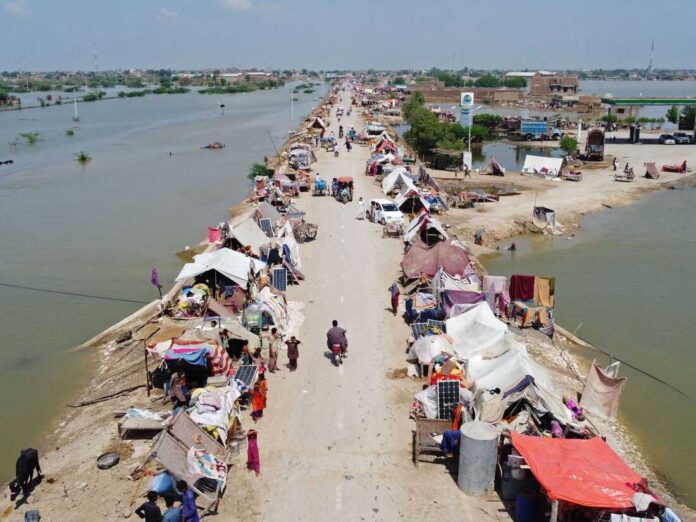Climate change is not the only reason to blame. There has been corruption, weak governance or inadequate planning. Ineffective water management is majorly to blame for the severity of the present calamity.
The last week of June saw the onset of the monsoon season in Pakistan. Pakistan just had three weeks to experience 60 percent of its typical monsoon rainfall after the season began. Glacial Lake Outburst Floods were generated by heavy rainfall throughout Pakistan, particularly in Punjab, Khyber Pakhtunkhwa, Sindh, and Baluchistan. Over 7.9 million individuals need support after experiencing temporary displacement. Homes, farms, and vital infrastructures, such as roads, bridges, schools, hospitals, and public health centres were destroyed as several major rivers burst their banks and dams spilled. The affected people urgently need a place to stay and emergency medical care.
Monsoon rain is a frequent occurrence in Pakistan, particularly in its northern regions. But what was unusual this season was that the country’s southern dry area saw five times the typical annual rainfall, which caused traditional, poorly maintained canals to overflow and poorly constructed, muddy, and sand-based protection embankments to collapse.
Pakistan emits less than one percent of the greenhouse gases that cause global warming, but between 1952 and 2009, the country’s temperatures increased by 0.3°C each decade, above the worldwide average. The extraordinary weather events in April and May of this year, which saw several locations experience temperatures exceeding 40°C for extended periods, were brought on by this progressive warming of the climate.
Flash floods may have been brought on by climate change, but poor leadership and management made the resulting humanitarian situation much worse. If the present government and its predecessors had acted promptly and in a proactive manner to address basic concerns like climate change, the disastrous effects would have been lessened.
The country’s northern mountainous areas, which are home to the majority of glaciers outside of the Arctic areas, saw glacial melt as a result of the intense heat, which increased the volume of water flowing into rivers that ultimately fall into the Indus. Pakistan is crossed by the Indus River from north to south, supporting many towns, cities, and vast tracts of arable land.
The water collection was made worse by improper water management. As a consequence, several underdeveloped towns and villages in Balochistan and Sindh were submerged. Standing water rose as much as three to six meters in certain areas of Sindh
Balochistan experienced the same thing. Flash floods induced by water buildup and invasion in certain areas wiped away roads, bridges, homes, and hundreds of thousands of acres of crops.
As Federal Climate Change Minister Sherry Rehman and others have noted repeatedly, the flash floods that ravaged Sindh and Balochistan were not only the effect of climate change.
The effects of climate change in Pakistan are undeniable, as shown by heat waves, such as the all-time high temperature of 53.5°C in Turbat, Baluchistan, in May 2017, and the frightening rate of glacier melting in the Himalayan Mountains. However, the poor infrastructure and lack of adequate floodplains have increased the flooding’s severity.
Rehman dislikes bringing up or discussing her government’s lack of readiness and inadequate floodplain regulation. She neglected to mention Sindh province’s inadequate infrastructure and deficient water management system. Now, millions of people face a serious health risk due to the nation’s inadequate to nonexistent public health and inability to adequately drain the accumulated floods in certain locations.
The government was unprepared to treat a disaster-like situation. There are several reasons why the present flooding is the most severe and deadly in Pakistan’s 75-year history. Although comparable calamities occurred in 2007, 2010, and 2012, the country was unprepared to handle a significant flooding crisis. The effect of the calamity was worsened this time due to a lack of planning and preparation, and it will only become worse if the water that has gathered in the flood-affected regions doesn’t evaporate.
Additionally, the focus on developing infrastructure and housing projects on natural floodplains contributed to greater harm being done to both the people and the environment. We witnessed this in Swat, where expensive hotels and cafes were instantly destroyed by floodwater.
Flash floods may have been brought on by climate change, but poor leadership and management made the resulting humanitarian situation much worse. If the present government and its predecessors had acted promptly and in a proactive manner to address basic concerns like climate change, the disastrous effects would have been lessened.
Since laws are affected by political objectives and self-interests and local governments are inactive, Pakistan lacked long-term strategy, climate-resilient initiatives, suitable water infrastructure, flood-resilient development plans, and an efficient drainage system.























